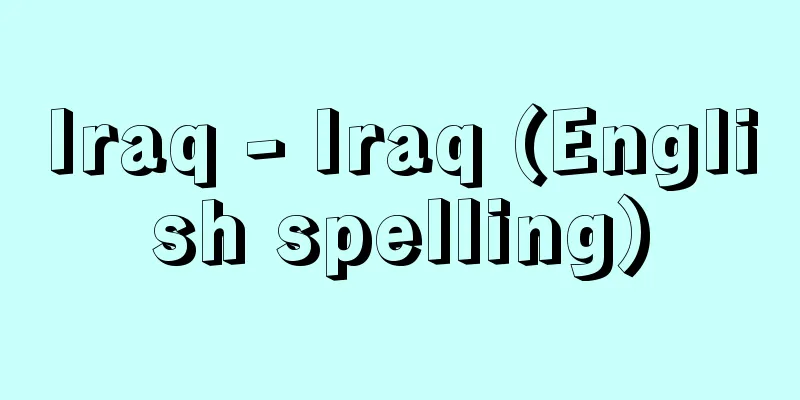Iraq - Iraq (English spelling)

|
A country located in Western Asia. Its official name is the Republic of Iraq (Al-Jumhūrīyah al-'Irāqīyah) and in English is the Republic of Iraq. It borders Turkey to the north, Iran to the east, Syria and Jordan to the west, Saudi Arabia and Kuwait to the south, and part of the south faces the Persian Gulf (Arabian Gulf). It has an area of 438,317 square kilometers, a population of 28,993,000 (estimated in 2007), and a population density of 66 people per square kilometer. The capital is Baghdad. In ancient times, Iraq was called Mesopotamia and was an agricultural country with the vast and fertile Tigris and Euphrates river basins as its main part. In the 20th century, however, it began to actively work on industrialization, backed by its abundant oil resources. Politically, the country changed from a monarchy to a republic in the 1958 revolution (Iraqi Revolution), but political instability continued. However, the Ba'ath Party's Bakr government, which was established in a coup in 1968, gained a relatively stable footing from the late 1970s. In 1979, Saddam Hussein became president and maintained his long-term rule through the Iran-Iraq War (1980-88) and the Gulf Crisis and Gulf War (1990-91). However, in 2003, the Iraqi government was attacked by both the US and UK forces and collapsed. After passing through governing bodies such as the Coalition Provisional Authority (CPA), the Provisional Government, and the Transitional Government, a new government was established in 2006. [Ryuichi Hara and Yusuke Yoshida] NatureIraq can be roughly divided into three regions. The Tigris and Euphrates river basins run through the center of the country, the mountainous region of Kurdistan bounding the north and northeast, and the desert region of the Syrian-Arabian plateau occupying the west and southwest. The Mesopotamian plains of the Tigris and Euphrates river basins make up 82% of Iraq's total land area and are the most important part of Iraq's natural environment. These river basins are further divided into the upper and lower reaches by a line connecting Samarra on the Tigris River and Hit on the Euphrates River. The upper reaches are the rugged Jazira Hills at an altitude of about 500 meters, forming a small basin with countless wadis (dried valleys) with no outlet. The lower reaches are alluvial plains, and irrigation from the two rivers makes them the agricultural center of Iraq. The Shatt al-Arab River, where the Tigris and Euphrates rivers join, forms a marshland covered with thick reeds. The Kurdistan Mountains border Iran and Turkey, and are a steep, folded mountain range that is connected to the Zagros Mountains in Iran, with some mountains reaching heights of over 3,000 meters. The main stream of the Tigris River and its tributaries, the Great Zab River and the Little Zab River, flow down through the plains cut through by the valleys of the Great and Little Zab Rivers, which constitute the land of ancient Assyria. The desert region that occupies the western and southwestern parts of Iraq gradually rises from the lowlands downstream of the Euphrates River, forming a plateau up to 1,000 meters above sea level. The northern part is an extension of the Syrian Desert, and the Hijara Desert in the south forms the northern edge of the Nefud Desert in Saudi Arabia. Many wadis are carved into the desert toward the Mesopotamian plain, the largest of which, Wadi Hawran, is 480 km long. The climate has two contrasting seasons: a dry, hot summer from May to October in the lowlands, and a relatively warm, humid winter from December to March. Winters are severely cold in the mountains. The average annual temperature in Baghdad is 22°C, but in July it is 34.2°C, and even in the shade it can reach 43°C during the day. This causes residents to spend the daytime in basements to escape the heat. The lowest average temperature is 8.5°C in January, and there is a large temperature difference. The world's highest temperature, 58.8°C, was observed in Basra on July 8, 1921. Precipitation exceeds 400 mm per year in the Kurdistan Mountains, but gradually decreases toward the southwest, with only around 150 mm in Baghdad. The desert area becomes even drier and barren, making farming impossible. The Tigris, Euphrates and their many large and small tributaries collect rainfall from the Kurdistan Mountains and the mountains and plateaus of Turkey, and are blessed with abundant water. [Ryuichi Hara and Yusuke Yoshida] historyAncient times - before World War IMesopotamia is the land of the world's oldest civilization. In 3000 BC, Sumer had established its own culture with its own writing system. Subsequently, the Babylonian and Neo-Babylonian kingdoms arose along the Euphrates River, and the Assyrian kingdom along the upper reaches of the Tigris River. However, after the Achaemenid Empire of Iran conquered Iraq in 539 BC, Iraq was invaded and ruled by external powers such as Alexander the Great, Parthia, and the Sassanid Empire of Persia. In the mid-7th century, Islam appeared in the Arabian Peninsula, and Muslim groups defeated the Sassanid army that had ruled Iraq, ushering in a new era. During the Umayyad period, the center of the Islamic empire was in Syria, but when the Abbasid period began in 749, the capital was located in Kufa and Baghdad in Iraq, and enjoyed prosperity on a par with Chang'an of the Tang Dynasty and Constantinople of the Byzantine Empire. After that, the dynasty gradually lost its power, and independent governments were successively established in Iran, Central Asia, Egypt, and North Africa, and Baghdad's economic center was taken over by Egypt. In 1258, the Abbasid Caliphate was destroyed by the Mongol army, and Baghdad was devastated by massacres and destruction. Furthermore, at the end of the 14th century, the Mongol army led by Timur invaded Iraq, destroying the irrigation facilities that were its lifeline. For about 400 years, from 1534 until World War I, Iraq came under the rule of Ottoman Turkey as a province. During that time, it was often a battlefield in the battles between the Turkish army and the Iranian army of the Safavid dynasty. After World War I until the establishment of the Republican governmentDuring World War I, Turkey joined the German and Australian sides, and British and Indian troops landed near Basra, conquering Turkey and occupying most of Iraq in 1918. At that time, nationalist movements were on the rise within the country, and rebellions broke out in many regions. In 1920, Britain was granted the right to govern Iraq at the San Remo Conference, and Faisal of the Hashemite family of Mecca was appointed as King and administered the country by the Mandate. King Faisal revised the treaty with Britain many times thereafter, moving forward on the path to independence, and in 1932 he joined the League of Nations and achieved his long-cherished goal of independence. After World War II and the chaos that followed, the national economy began to flourish with oil revenues, and in 1953, the young King Faisal II ascended to the throne. With the King's full support, Nuri al-Sa'id exercised his dictatorial skills as Prime Minister, and it seemed that the political situation would stabilize. However, in July 1958, a military coup led by Brigadier General Abdul Karim Qassem succeeded in assassinating the King, the Crown Prince, many members of the royal family and the Prime Minister, and establishing a republican government. The Rise of the Baath PartyThe 1958 coup d'état saw Iraq's Qassem government transform from a monarchy to a republic, and it withdrew from the Baghdad Pact (later known as the Central Treaty Organization CENTO) and promoted neutralist and pro-Soviet policies. After that, domestically, there were military rebellions, the rise of the Communist Party, and Kurdish rebellions, and externally, there was conflict among the leadership over the territorial dispute with Iran over the Shatt al-Arab River and the annexation of Kuwait, leading to continued political instability. Then, in February 1963, a coup d'état by Baathist officers collapsed the Qassem government. The new government's president, Aref, soon cooperated with the military and succeeded in wiping out the Baathist forces. As a result, pro-Egyptians rose to power, and a series of socialist policies were put into place, including the establishment of a single political party, the Arab Socialist Union, and the nationalization of important companies. After several political upheavals, a Baathist government was established in July 1968 in a coup d'état by moderate General Ahmad Hassan Bakr and others. Bakr became president and a provisional constitution was promulgated in September. However, internal conflict within the Ba'ath Party was intense, and there were a series of attempted coups. In 1972, the Treaty of Friendship and Cooperation with the Soviet Union was signed, and a conflict between Iraq, which was under Soviet influence, and Iran, which was under American influence, became established. Against this backdrop, the long-standing issue of nationalizing the Iraqi Petroleum Company (IPC) was carried out, but the resulting significant drop in crude oil production put pressure on the national economy. On the other hand, the conflict with major Western oil companies helped to unify public opinion and solidify the people's hearts, contributing to the stability of the Bakr regime. In October 1973, Iraq restored diplomatic relations with Shah Pahlavi's Iran in the wake of the Fourth Arab-Israeli War, and in 1975 put an end to the border dispute between the two countries. As a result, Iran stopped supporting the Kurds, an ethnic minority group that had risen up in arms in Iraq demanding autonomy. At the same time, Iraqi government forces launched an all-out attack on the Kurds, and the 15-year long struggle for liberation was put down. Relations between Iraq and the Soviet Union, which were considered the most pro-Soviet among the Middle Eastern countries, deteriorated in 1978. In addition to differences in foreign policy and the desire to move away from a one-sided Soviet dependency, the Soviet Union's support for the Iraqi Kurds also stimulated the Iraqi government. In the midst of the turbulent Middle Eastern situation, including the 1978 Egypt-Israel Peace Agreement and the 1979 Iranian Revolution, President Baqir, who had been in power for 11 years, retired for health reasons in July 1979, and was succeeded by Saddam Hussein, vice chairman of the Revolutionary Council, who had effectively held real power. From then on, although the country maintained the form of a republic, in reality President Hussein's dictatorship was strengthened. PoliticsIn September 1980, the Iran-Iraq War broke out over a border dispute with Iran, which was in the midst of chaos after the revolution. The war dragged on, with both sides suffering heavy human and material losses, and a ceasefire was reached in August 1988. In August 1990, Iraqi forces invaded Kuwait. In response, the UN Security Council immediately resolved to impose economic sanctions on Iraq and invalidate the annexation of Kuwait. On January 17, 1991, the Gulf War began with a multinational force led by the United States, and the Iraqi army was routed by attacks using high-tech weapons, and Kuwait was liberated on the 26th. A ceasefire was reached on April 11. After the war, a "safe zone" was established in the Kurdish autonomous region in northern Iraq, with a no-fly zone designated for the Iraqi army to protect the Kurds. However, in August 1996, due to conflict between the Kurdistan Democratic Party (KDP) and the Patriotic Union of Kurdistan (PUK), the Iraqi army invaded the Kurdish autonomous region at the request of the KDP for support. Shortly after, the United States decided to use force, firing a total of 44 cruise missiles at Iraqi air defense facilities, and the Iraqi army withdrew within a few days. In addition, the domestic economy and industry were devastated by the economic blockade after the Gulf War, and public security deteriorated severely. In December 1996, an assassination attempt was made on Hussein's eldest son, Uday. In 2002, UN inspections of weapons of mass destruction were resumed, but Hussein continued to be uncooperative and became internationally isolated. In March 2003, Hussein refused to seek asylum in response to an ultimatum from the United States, and on the 20th of the same month, the US and British forces attacked Iraq, starting the Iraq War. In April of the same year, American and British forces took control of the capital Baghdad and other major cities in Iraq, causing the collapse of Hussein's regime, and he was captured by American forces in December. After the collapse of the Hussein regime in April 2003, the whole of Iraq came under the occupation and rule of the United States and the United Kingdom's Coalition Provisional Authority (CPA). In July of the same year, the Iraqi Governing Council was formed, composed of Iraqis, but the CPA was the highest decision-making body of the occupation regime. On June 1, 2004, through discussions between the UN, the CPA, and the Governing Council, Ayad Allawi was appointed Prime Minister and Ghazi Azil Yawar was appointed President, and the cabinet was also decided, and the Iraqi Interim Government was established (the Governing Council was dissolved). On June 28 of the same year, sovereignty was transferred from the CPA to the Iraqi Interim Government. At the same time, the CPA was dissolved, and the occupation by the United States and the United Kingdom ended, but the multinational forces, mainly from the United States and the United Kingdom, continued to be stationed in Iraq at the request of the interim government. In January 2005, the National Assembly election was held, and the Shiite Muslim forces won and won the majority of the seats. In April of the same year, the National Assembly elected Kurdish leader (Chairman of the Patriotic Union of Kurdistan) Jalal Talabani as president of the Iraqi transitional government. Talabani took office as president and appointed Shiite Ibrahim Jafari as prime minister, forming a transitional government. A new constitution was approved by a national referendum in October 2005. National Assembly elections based on the new constitution were held in December of the same year, and in April 2006 the National Assembly elected a new Speaker and President, and the President appointed a new Prime Minister, and a new Iraqi government was formed in May of the same year. The Assembly is unicameral with 275 seats. 230 of these are elected by proportional representation in each province, and 45 by national proportional representation with priority given to minorities. The term of office is four years. The term of office of the President, who is elected by the Assembly, is also four years. The President is the Head of State, but the Prime Minister holds executive power and is also the Supreme Commander of the Armed Forces. The local administration is made up of 18 provinces, including the capital Baghdad and the three Kurdish autonomous provinces, and local assembly elections were held in 14 provinces in January 2009. After the collapse of the Saddam Hussein regime, the multinational forces stationed in Iraq for security measures and reconstruction support activities began to withdraw when the UN Security Council resolution expired at the end of 2008. In January 2009, a three-year Status of Forces Agreement came into effect between Iraq and the United States. This agreement included provisions such as the withdrawal of US forces from all Iraq by the end of 2011, the withdrawal of US combat forces from cities and villages by the end of June 2009 as Iraqi security forces regain security authority in each province, and the Iraqi side having primary jurisdiction over any serious crimes committed by US troops outside of their duties. Based on this agreement, US forces completed their withdrawal from urban areas in June 2009. The number of troops in Iraq's security forces, including the army and police, is approximately 360,000. Of these, the Iraqi army consists of 163,500 in the army, 1,100 in the navy, and 1,200 in the air force (2008). In July 2004, a special tribunal was opened to try Hussein and other senior members of the former regime, and Hussein's first hearing was held in October 2005. Although he pleaded not guilty to the charges, in November 2006 the Iraqi High Tribunal (renamed from the Special Tribunal) sentenced him to death (by hanging) for crimes against humanity. The death sentence was finalized on December 26 of the same year, and the sentence was carried out on the 30th. The execution, which still had cases pending, was questioned by the Sunni Muslims who had controlled the former regime, as well as the international community. Even after Bush declared the end of large-scale fighting in May 2003, chaos continued in Iraq, with frequent terrorist attacks and, at one point, the country was in a state of civil war, resulting in over 2 million Iraqi refugees. [Ryuichi Hara and Yusuke Yoshida] Economy and IndustrySince the republican revolution of 1958, Iraq has basically been moving towards socialism, but in the economic field it has promoted cooperation with Western countries by separating politics and economics. However, since the Iraqi army's invasion of Kuwait in 1990, the UN has imposed an economic blockade, and the Iraqi economy was devastated by the Iraq War in 2003. As a result, economic life and industrial production in Iraq are in an extremely difficult situation. However, economic sanctions were partially lifted in December 1996, and oil exports to the tune of $2 billion were resumed in six months, but only for humanitarian purposes such as purchasing food and medical supplies. Before the Gulf War, Iraq's economy was the fifth largest in crude oil production in the world (1989), and was truly dependent on oil. This situation is expected to remain unchanged even after the country's return to the international community. Oil accounts for an overwhelming majority of Iraq's fiscal revenues, at 85%. Between 1972 and 1975, the government nationalized the Iraqi Oil Company IPC (with British, American, Dutch, and French capital) and its affiliates, and pursued an aggressive oil policy. It promoted exploration and development of new oil fields, as well as expansion projects for major oil fields such as Kirkuk, Ain Zalaha, and Zubair. As a result of these development efforts, Iraq's oil production, which was 2.4 million barrels (daily) in 1975, reached 3.3 million barrels in the first half of 1979. With a significant increase in production and the increase in crude oil prices by the Organization of the Petroleum Exporting Countries (OPEC) in 1979, oil revenues continued to increase. The agricultural sector employed only 7.9% of the total workforce (2005). More than half of the country's land area is barren, with only 13% of the total area cultivated (2000). Moreover, the only land that can be cultivated using rainwater is the mountainous region in the north, where the annual rainfall exceeds 400 mm. The Mesopotamian Plain, the main agricultural region, relies on irrigation. Land productivity is low, and various efforts are being made to improve it. Agricultural reform was implemented in 1958, and in the process, collectivization and mechanization were promoted. Agricultural development, such as the construction of dams, the development of irrigation facilities, the development of new farmland, and the improvement of varieties, is also active. However, the effects of development investment in the agricultural sector are slow to appear, and at the same time, agricultural imports continue to increase due to growing consumer demand. The main winter crops are wheat, barley, flax, and beans, while the summer crops are rice, cotton, tobacco, corn, millet, and vegetables. Date palms are cultivated in the downstream basins of both the Tigris and Euphrates rivers, and the country's production volume is among the largest in the world. In recent years, grain production has plummeted from approximately 3 million tons in 1996 to approximately 800,000 tons in 2000. This is thought to be due to two consecutive years of drought from 1998 and the difficulty in securing agricultural machinery, fertilizer, and other production materials caused by economic sanctions. The manufacturing industry only accounted for about 17.5% of the workforce (1990), and has yet to become a major sector in the Iraqi economy. In addition to traditional industries such as food processing, textiles, brick making, and tanning, modern industries such as cement, oil refining, petrochemicals, steel, and machinery have also emerged. In particular, from the mid-1970s after the oil boom, the government actively worked on industrialization. As a result, the growth of the oil refining industry was outstanding, and the food industry and non-metallic building materials industry also saw rapid growth. Since the monarchy, several five-year plans have been drawn up for economic development, but constant political upheavals have led to delays and interruptions to these plans. The fifth five-year plan from 1981 to 1985 was also not substantially implemented. Subsequent economic plans have been disrupted by events such as the Gulf War and the Iraq War. Before the Iraq War, petroleum (crude oil and petroleum products) accounted for 99% of total exports. In 1989, the top export destinations were the United States, Brazil, Turkey, and Japan, in that order, but in 2001, the top export destinations were the United States, Italy, France, and Spain. The main imports were machinery, transport machinery, grains, steel, and textiles, but with the economic development boom, the focus shifted from consumer goods to intermediate materials and investment materials such as iron and non-ferrous metal products and machinery. In 1989, the top import partners were the United States, Germany, the United Kingdom, Japan, France, and Turkey, with a trade surplus of 2.477 billion dollars. However, trade was limited due to the imposition of economic sanctions, and in 2001 the top import partners were the United States, Australia, China, Italy, and Jordan, with the main imports being food, medical supplies, and consumer goods. One year after the new government was inaugurated, Iraq's GDP (preliminary figures) for 2007 was $62.4 billion, and its GDP per capita was $2,109. Iraq's oil reserves were 115 billion barrels (2007), the third largest in the world. Average oil production was 2.15 million barrels per day (2007), reaching 2.31 million barrels per day in 2008, with both production and exports exceeding those just before the Iraq War. [Ryuichi Hara and Yusuke Yoshida] societyThe population is made up of many ethnic groups, with Arabs making up nearly 80% of the total. The largest minority group is the Kurds, accounting for nearly 20% of the total population. They are a Persian people who live mainly in the Kurdistan region in the northwest, spanning Iran, Turkey, and Syria. They differ from Arabs in both ethnicity and language, and have long been in conflict with the central government, demanding autonomy. Other ethnic groups living in Iraq include Turks in northern Iraq and Iranians in the center, as well as Turkmens, Assyrians, Armenians, Yazidis, Shabaks, Sabaeans, and Jews. Arabic, the official language, is the most widely spoken, although Kurdish and Turkish are more common in the north, and Assyrian, Armenian and dialects of Persian are also spoken among tribes in the east. Religion is also an important factor that divides Iraq's population. Over 95% of the total population is Muslim, roughly split between Sunnis and Shiites. Sunnis are Arabs and Kurds, including the citizens of Baghdad and Basra, while Shiites are Arabs and Iranians living around the holy city of Karbala, making up about 60% of the total population. Christians, including Nestorians, Gregorians, Greek Orthodox, and Armenian Orthodox, are estimated to number more than 200,000 in total. There are also a small number of Jews. The three major cities of Baghdad, the capital, Basra and Mosul, as well as other cities, have rapidly developed and modernized. However, they suffered great damage in the 2003 Iraq War. In rural areas, residents' homes are made of stacked sun-dried bricks, and it is common for them to live without electricity or running water. The only form of entertainment is gathering at outdoor coffee shops to enjoy conversation while sipping Turkish coffee, and grand Islamic festivals and weddings are held to break up this monotonous life. The education system made great strides in the 1970s, and in 1974-1975, it was decided to make all stages of education from primary school to university free, and to abolish private schools and make them public. Furthermore, while primary education was compulsory for those aged 6-12, there were plans to extend this to three years of secondary education. Thanks to these proactive government policies, the literacy rate of the nation's citizens increased, reaching 74.2% in 2000 (84.1% for boys, 64.2% for girls). However, the Iraq War has also caused great damage to the country's education system. According to a 2004 Iraqi government survey, over 700 schools were destroyed by airstrikes and over 3,000 were looted. As a result, schools throughout Iraq are suffering from a shortage of basic school supplies, including chairs and desks. A British NGO has reported that, although 4.3 million students are registered for primary education, an estimated 800,000 or more are not attending school. [Ryuichi Hara and Yusuke Yoshida] cultureThis country, where the world's oldest civilization flourished, has many ruins and ancient architecture. In southern Mesopotamia, in the Euphrates River basin, there are the ancient Sumerian ruins of Ur, Eridu, and Uruk, and south of Baghdad, there are the ruins of Babylon, which flourished as the capital of Babylonia and Neo-Babylonia. Many of the excavated items from these ruins are kept in the Iraq Museum in Baghdad. The Assyrian Empire, which arose after the Babylonian Empire, was located in northern Iraq, upstream of the Tigris River. Its representative ruins are Nineveh and Nirmud near Mosul, the center of the north, and the remains of the city walls and palace of Ashur, about 60 kilometers south. The ruins of the city of Hatra, built by Bedouins who migrated after the collapse of the Assyrian Empire, are located south of Ashur. Ctesiphon, the winter capital of the Sassanid Persian Empire, is located about 30 kilometers southeast of Baghdad, and the remains of the royal palace with the largest arch among ancient ruins remain. After the fall of the Neo-Babylonian Empire, Mesopotamia lost its cultural center to Persia, and the Abbasid culture flourished in the 8th century, centered on Baghdad. In Baghdad and Samarra, 120 kilometers north, there are ruins of royal palaces, mosques, mosque minarets, and spiral minarets. These ancient cultural ruins are under the jurisdiction of the government's Directorate of Archaeology and Culture, and excavation, investigation, and research are being carried out. The mosques of Najaf and Karbala, which contain the tombs of Ali, the founder of Shiite Islam, and his son Hussein, are not just ruins, but are still sacred sites that attract the devout faith of believers. Before the Iran-Iraq War and the Gulf War, many pilgrims came from Iran, Pakistan, and other countries. [Ryuichi Hara and Yusuke Yoshida] Relations with JapanIn 1964, the Japan-Iraq Trade Agreement was signed, lifting restrictions on imports to Japan. In August 1974, an economic cooperation agreement was signed, under which Japan would provide a loan of $2 billion in return for a stable supply of 90 million tons of crude oil and 70 million tons of petroleum products from Iraq over a 10-year period. Since then, economic relations between Japan and Iraq have rapidly deepened, and in 1977, Japan's share of Iraq's import dependency was 20%, ranking first. However, Japan's share has since declined, and in 1989, Iraq's exports to Japan were 8%, fourth after the United States, Brazil, and Turkey. Iraq's import dependency on Japan was 5%. In 2007, exports to Japan were $1,018 million, and imports were $120 million. Cooperation between the two countries also deepened in areas other than economics. In March 1978, the Japan-Iraq Cultural Association was established, and the Japan-Iraq Airways Agreement was signed. This resulted in Iraqi Airways flying to Tokyo, some of Japan Airlines' southern European routes, and flights to Baghdad on Middle Eastern routes. Before the Gulf War, there was a wide range of exchanges, including the dispatch of politicians, cultural and sports organizations, and archaeological excavation teams, and Japanese companies participated in many projects related to Iraq's economic development plans. However, after the Gulf Crisis, Japan implemented economic sanctions against Iraq, and in 1991 closed the Japanese Embassy in Iraq. The relationship between Japan and Iraq changed significantly before and after the Gulf War, but after 1999, members of the Diet and directors-general of the Ministry of Foreign Affairs visited Iraq, and dialogue was not closed. Economic cooperation with Iraq, which had reached about 190 billion yen before the Gulf War, was halted, but humanitarian aid through international organizations continued. However, during the Iraq War in 2003, Japan took a position supporting the United States and the United Kingdom.になったんです。 English: The first thing you can do is to find the best one to do. In May 2004, two Japanese freelance journalists (Hashida Shinsuke and Ogawa Kotaro) and one Iraqi interpreter accompanied by an Iraqi interpreter were attacked and killed near Baghdad. In October of the same year, one civilian (Koda Shosei) visited Baghdad was abducted and killed by an Islamic fundamentalist terrorist organization, an al-Qaeda group, and five Japanese people were killed after the war began. After that, as the power to maintain public order was transferred from the multinational forces to Iraq, the Ground Self-Defense Force withdraws in 2006. In December 2008, the Air Self-Defense Force began withdrawing (complete withdrawal was made in February 2009), and the Self-Defense Forces' efforts to support the reconstruction of Iraq ended. [Ryuichi Hara and Yusuke Yoshida] になったんです。 English: The first thing you can do is to find the best one to do . Iraq (2002, Kokudosha) ▽ Kunisue Norito, "The Abyss of the Iraq War - When Power Collapse, 2002-2004" (2007, Soshisha) ▽ Ogura Takayasu, "War and the People - What Happened in Iraq" (2008, Mainichi Shimbun) ▽ Takahashi Hidehiko, "A Journey to the History of Iraq: The Tigris Euphrates" (NHK Books) ▽ Kodama Shinjiro, "History of West Asia" (Kodansha Gendai Shinsho) ▽ Sakai Keiko, "Iraq and America" (Iwanami Shinsho) ▽ Kishitani Miho, "What I Learned on the Battlefield of Iraq" (Iwanami Junior Shinsho) [Reference items] | | | | | | | | | | |Karvara| | | | | | | |Tigris| |Baghdad| |Bathra| | |Babylon| | | | | [Complementary Materials] |"> Iraqi flag ©Shogakukan Illustration/Shogakukan Creative "> Iraq location map Ancient Babylonian city ruins. The photo shows a part of the Ishtar gate, consisting of double gates. Southern suburbs of Baghdad, Iraq © Shogakukan "> Babylonian Ruins Source: Shogakukan Encyclopedia Nipponica About Encyclopedia Nipponica Information | Legend |
|
西アジアに位置する国。正式名称はイラク共和国Al-Jumhūrīyah al-‘Irāqīyah、英語ではRepublic of Iraqという。北はトルコ、東はイラン、西はシリアとヨルダン、さらに南はサウジアラビアとクウェートに接し、南部の一部がペルシア湾(アラビア湾)に臨む。面積43万8317平方キロメートル、人口2899万3000(2007推定)、人口密度は1平方キロメートル当り66人。首都はバグダード。 古くはメソポタミアとよばれ、肥沃(ひよく)で広大なティグリス、ユーフラテス両川流域を主要部とする農業国であったが、20世紀になり豊かな石油資源を背景に工業化に積極的に取り組むようになった。政治的には1958年の革命(イラク革命)で王制から共和制に転換したが政情不安が続いた。しかし、1968年のクーデターで生まれたバース党のバクル政権は、1970年代後半から比較的安定した基盤を得た。1979年にはサダム・フセインが大統領に就任し、イラン・イラク戦争(1980~88)、湾岸危機・湾岸戦争(1990~91)を経て長期政権を維持したが、2003年のイラク戦争でアメリカ・イギリス両軍の攻撃を受け、フセイン政権は崩壊、連合国暫定当局(CPA)から暫定政府、移行政府による統治機関を経て、新政府が2006年に発足した。 [原 隆一・吉田雄介] 自然イラクは大別して三つの地域に分けられる。国土の中央部を流れるティグリス、ユーフラテス両川流域、北から北東を限るクルディスターン地方の山岳地域、ならびに西部、南西部を占めるシリア・アラビア台地の砂漠地域である。なかでもティグリス、ユーフラテス両川流域のメソポタミア平原はイラク総面積の82%を占め、イラクの自然環境のなかでもっとも重要な意味をもっている。この両川流域は、ティグリス川沿岸のサマッラー、ユーフラテス川沿岸のヒートを結ぶ線でさらに上流域と下流域に分けられる。上流域は標高500メートル前後の起伏の多いジャジーラ丘陵となり、流出口のない無数のワジ(涸(か)れ谷)のつくった小盆地を形成している。下流域は沖積平野となり、両川からの灌漑(かんがい)によりイラクの農業の中心地帯となっている。ティグリス、ユーフラテス両川が合流したあとのシャッタル・アラブ川沿岸はアシの生い茂る沼沢地帯を形成している。クルディスターン山地はイラン、トルコの国境に接し、イランのザーグロス山脈に連なる急峻(きゅうしゅん)な褶曲(しゅうきょく)山脈で、標高3000メートルを超える高山もみられる。ティグリス川の本流やその支流の大ザーブ川、小ザーブ川などが流下し、大小ザーブ川の谷が貫く平原一帯が古代のアッシリアの地である。イラクの西部、南西部を占める砂漠地帯は、ユーフラテス川下流低地からしだいに高くなり、標高1000メートルまでの高原を形成している。北部がシリア砂漠の延長であり、南部のヒジャーラ砂漠はサウジアラビアのネフド砂漠の北縁となっている。砂漠地帯にはメソポタミア平原に向かって多くのワジが刻まれ、最大のワジ・ハウラーンは全長480キロメートルに達する。 気候は、低地では5月~10月の乾燥し暑さの厳しい夏と、12月~3月の比較的温暖で湿潤な冬との対照的な二つの季節がある。山地では冬は寒さが厳しい。バグダードの年平均気温は22℃であるが、7月の平均気温は34.2℃で、日中は日陰でも43℃に達する。このため住民は暑さを逃れるため昼間は地下室で過ごす。最低平均気温は1月の8.5℃で気温差は大きい。1921年7月8日バスラで観測された58.8℃は世界最高記録である。降水量は、クルディスターン山地では年間400ミリメートルを超えるが、南西部へ向かうにつれてしだいに減じ、バグダードでは150ミリメートル前後にすぎない。砂漠地帯ではさらに乾燥し、農耕の不可能な不毛の地となる。ティグリス、ユーフラテス両川をはじめとしてその大小の支流は、クルディスターン山地やトルコの山地、高原の降水を集め、豊かな水量に恵まれている。 [原 隆一・吉田雄介] 歴史古代~第一次世界大戦前メソポタミアは世界最古の文明を擁した地である。紀元前3000年、シュメールは自らの文字をもつ独自の文化を築いていた。続いてユーフラテス川流域にバビロニア王国、新バビロニア王国が、ティグリス上流にアッシリア王国が興って栄えた。しかし、前539年イランのアケメネス朝ペルシアが征服して以後、イラクはアレクサンドロス大王、パルティア、ササン朝ペルシアなど外部勢力の侵入、支配を受けた。7世紀なかばイスラム教がアラビア半島におこり、イスラム教徒団はイラクを支配していたササン朝軍を破り新時代を開いた。ウマイヤ朝時代にはイスラム帝国の中心はシリアに置かれたが、749年からアッバース朝時代が始まると、首都はイラクのクーファ、そしてバグダードに置かれ、唐の長安、ビザンティン帝国のコンスタンティノープルと並ぶ繁栄を享受した。その後この王朝はしだいに勢力を失い、イラン、中央アジア、エジプト、北アフリカに続々と独立政権ができ、経済上の中心もエジプトに奪われることになった。1258年アッバース朝はモンゴル軍に滅ぼされ、バグダードは殺戮(さつりく)と破壊によって荒廃した。さらに14世紀末にティームールの率いるモンゴル軍が攻め寄せ、生命線ともいえる灌漑施設を破壊した。1534年から第一次世界大戦に至るまで約400年の間、イラクはオスマン・トルコの属州としてその支配下に置かれた。その間トルコ軍とサファビー朝のイラン軍との戦いの戦場となることも多かった。 第一次世界大戦後~共和国政権樹立まで第一次世界大戦の際にはトルコがドイツ、オーストラリア側について参戦し、イギリス・インド軍がバスラ付近に上陸、1918年トルコを制圧しイラクの大部分を占領した。このころ国内では民族運動が高まり、多くの地域で反乱が生じた。1920年サン・レモ会議でイラクの委任統治権を認められたイギリスは、メッカのハーシム家のファイサルを国王として迎え委任統治を実施した。ファイサル国王はその後たびたびイギリスとの条約を改定し、独立への歩を進め、1932年国際連盟に加入して念願の独立を果たした。第二次世界大戦そして戦後の混乱ののち、石油収入で国民経済も潤い始めた1953年、若いファイサル2世が即位した。国王の完全な支持のもとでヌーリー・アッサイードが首相として独裁的な敏腕を振るい、政局も安定するかに思われた。しかし1958年7月、アブドゥル・カーリム・カセム准将の率いる軍事クーデターが成功し、国王、皇太子、多くの皇族と首相らが殺害され共和国政権が樹立された。 バース党の台頭1958年クーデターで君主制から共和制に変わったイラクのカセム政権は、バグダード条約(後の中央条約機構CENTO(セントー))から脱退、中立主義的かつソ連寄りの政策を推進した。その後、国内では、軍部の反乱、共産党勢力の増大、クルド人の反乱、対外的には、イランとのシャッタル・アラブ川の領有権問題、クウェート併合などをめぐって、指導者層に対立が起こり政情不安が続いた。そして1963年2月バース党将校団によるクーデターでカセム政権は崩壊した。新政権の大統領アレフはまもなく軍と協力して、バース党勢力の一掃に成功した。この結果、親エジプト派が台頭し、単一政党「アラブ社会主義者連合」の設立、重要企業の国有化など一連の社会主義的政策が打ち出された。何度かの政変ののち、1968年7月穏健派のアハマッド・ハッサン・バクル将軍らによるクーデターでバース党政権が成立した。バクルが大統領に就任し、9月には暫定憲法が公布された。しかしバース党内の内紛は激しく、クーデター未遂事件は後を絶たなかった。1972年ソ連との友好協力条約に調印、ソ連の影響下に置かれたイラクと、アメリカの勢力下にあるイランとの対立という図式が定着した。こうした情勢を背景に、かねてより懸案のイラク石油会社(IPC)の国有化を断行したが、それに伴う大幅な原油生産量の減少は国民経済を圧迫した。しかし一方、西側大手石油資本との紛争は国内世論の統一と民心の結束に役だち、バクル政権の安定に寄与した。 1973年10月、第四次中東戦争を機にパーレビ国王のイランと国交を回復し、1975年両国間の国境紛争に終止符を打った。これによりイランは、イラク領内で自治権を要求して武装決起した少数民族のクルド人への支援を停止した。同時にイラク政府軍はクルド人に総攻撃を加え、15年間にわたったクルド人の解放闘争はいちおう鎮圧された。中東諸国のなかでもっとも親ソ的だとされたイラクとソ連の関係は、1978年に入ってから悪化した。対外政策の相違やソ連一辺倒からの脱皮といった原因のほかに、ソ連によるイラクのクルド人への支援もイラク政府を刺激した。1978年エジプト・イスラエル平和協定や1979年イラン革命など激動の中東情勢のなかで、1979年7月、11年間の長期政権を維持した大統領バクルが健康上の理由で引退、後任には実質上実権を握ってきたサダム・フセイン革命評議会副議長が就任した。以降、共和制のかたちをとりながらも、実質は大統領フセインの独裁体制が強化されていった。 政治1980年9月、革命後の混乱にあるイランとの間で、国境問題に端を発したイラン・イラク戦争が勃発(ぼっぱつ)した。戦争は長期化し、双方多大なる人的・物的損害を出して、1988年8月に停戦に至った。また、1990年8月にはイラク軍がクウェートに侵攻した。これに対して国連安全保障理事会はただちに対イラク経済制裁、クウェート併合無効を決議した。1991年1月17日、アメリカを主体とする多国籍軍による湾岸戦争が始まり、ハイテク兵器の攻撃によってイラク軍は潰走(かいそう)、26日にクウェートは解放された。4月11日、停戦が成立。戦後、イラク北部のクルド人自治区には、クルド人を保護すべくイラク軍の飛行禁止空域を定めて「安全地帯」が設置された。しかし、1996年8月にはクルド民主党(KDP)とクルド愛国同盟(PUK)との対立から、KDPの支援要請を受けてイラク軍がクルド人自治区に侵攻した。直後に、アメリカが武力行使を決定、イラクの防空施設に計44発の巡航ミサイルを打ち込み、イラク軍は数日で撤退した。また、湾岸戦争後の経済封鎖によって国内経済・産業は壊滅的な打撃を受け、治安も極度に悪化。1996年12月にはフセインの長男ウダイが襲撃される暗殺未遂事件が起こった。2002年には大量破壊兵器をめぐる国連査察が再開されるなどしたが、フセインは非協力的な態度をとり続け、国際的に孤立していく。2003年3月アメリカの最後通告に対してフセインは亡命を拒否、同月20日アメリカ・イギリス軍のイラク攻撃によりイラク戦争が始まった。同年4月には、アメリカ・イギリス両軍が首都バグダードをはじめとするイラク国内の主要都市を制圧、フセイン政権は崩壊し、フセインもまた12月にアメリカ軍に拘束された。 2003年4月のフセイン政権崩壊後、イラク全土は、アメリカ・イギリスによる連合国暫定当局(CPA)の占領統治に入った。同年7月イラク人よりなるイラク統治評議会が誕生したが、占領統治体制の最高決定機関はCPAであった。その後、2004年6月1日に、国連、CPA、統治評議会の協議により、評議会メンバーのなかからアヤド・アラウィが首相に、ガジ・アジル・ヤワルが大統領に就任、閣僚も決まり、イラク暫定政権が発足(統治評議会は解散)。同年6月28日には、CPAからイラク暫定政権への主権移譲がなされた。同時にCPAは解散し、ここにアメリカ・イギリスの占領統治は終了するが、アメリカ・イギリスを中心とする多国籍軍は暫定政権からの要請を受ける形をとって駐留し続けていた。2005年1月、国民議会選挙が行われた結果、イスラム教シーア派勢力が勝利し議席の過半数を占める。同年4月、国民議会は、イラク移行政府の大統領としてクルド人指導者(クルド愛国同盟議長)のジャラル・タラバニJalal Talabaniを選出、タラバニは大統領に就任し、シーア派のイブラヒム・ジャファリIbrahim Jafariを首相に指名、移行政府が発足した。 2005年10月には国民投票によって新憲法が承認された。同年12月には新憲法に基づく国民議会選挙が実施され、2006年4月に国民議会で改めて議長および大統領の選出、大統領による首相指名が行われ、同年5月にイラク新政府が発足した。議会は一院制で議席数は275。そのうち230は州ごとの比例代表制、45は少数派を優先した全国区の比例代表制で選ばれる。任期は4年。議会で選出される大統領の任期も連動して4年である。元首は大統領であるが、首相が行政権を握り、国軍の最高司令官を兼ねている。地方行政は首都バグダードやクルド人自治区3州を含む18州で構成され、2009年1月に14州において地方議会選挙が行われた。 フセイン政権崩壊後、治安対策や復興支援活動のためイラクに駐留していた多国籍軍は2008年末の国連安全保障理事会決議の期限切れを機に各国部隊が撤退を進めた。また、2009年1月にはイラク、アメリカ間で有効期間3年の地位協定が発効した。この地位協定には2011年末までに駐留アメリカ軍をイラク全域から撤退させること、2009年6月末までにイラク治安部隊が各州で治安権限を回復するのに合わせて都市部や村からアメリカ戦闘部隊を撤収、アメリカ軍側が任務外で重大な罪を犯した場合はイラク側が第一次裁判権をもつこと等が盛り込まれている。この協定に基づきアメリカ軍は2009年6月に都市部からの撤退を完了した。軍、警察などイラク治安部隊の兵力数は約36万。そのうちイラク軍は陸軍16万3500、海軍1100、空軍1200(2008)となっている。 2004年7月、フセインと旧政権幹部を裁く特別法廷が開廷し、2005年10月にはフセインの初公判が開かれた。本人は罪状認否で無罪を主張したが、2006年11月イラク高等法廷(特別法廷から改称)は人道に対する罪でフセインに死刑(絞首刑)判決を下した。同年12月26日には死刑が確定、同30日に刑が執行された。審理中の案件を残した刑執行には旧政権を握っていたイスラム教スンニー派をはじめ国際社会からも疑問視する声があがった。イラク国内は2003年5月にブッシュが大規模戦闘の終了を宣言した後も混乱が続きテロが頻発、一時は内戦状態となり200万人を超えるイラク難民が発生した。 [原 隆一・吉田雄介] 経済・産業イラクは1958年の共和制革命以来、基本的には社会主義化を進めながらも、経済分野では政経分離によって西側諸国との協調を推進した。しかしながら、1990年のイラク軍のクウェート侵攻以来、国連による経済封鎖が続き、2003年のイラク戦争によりイラク経済は壊滅的打撃を受けた。これにより、イラク国内の経済生活や工業生産はきわめて厳しい状況にある。なお、1996年12月には経済制裁が部分的に解除され、食料と医療品の購入という人道目的に限定して、半年で20億ドル分の石油輸出が再開されている。 湾岸戦争以前には世界第5位の原油生産量(1989)を誇っていたイラク経済は、まさに石油に依存していた。この状況は国際社会への復帰後も変わらないものと推測される。財政収入に占める割合は、石油が圧倒的に多く、85%に及んでいる。1972年から1975年にかけてイラク石油会社IPC(イギリス、アメリカ、オランダ、フランス資本)およびその関連会社を国有化した政府は、積極的な石油政策に取り組んだ。新油田の探査、開発や、キルクーク、アイン・ザラハ、ズベールなど主要油田の拡張プロジェクトを推進した。こうした開発努力の結果、1975年当時240万バレル(日産)であったイラクの産油量は、1979年前半に330万バレルを記録した。大幅な増産と、1979年に入ってからの石油輸出国機構(OPEC(オペック))による原油価格の値上げで、石油収入は増加の一途をたどった。 農業部門の就業人口は全就業者の7.9%(2005)にすぎない。国土面積の半分以上を不毛地が占め、耕地面積は13%(2000)にとどまる。しかも天水耕作が可能な土地は年降水量が400ミリメートルを超える北部の山岳地帯だけである。主要な農業地帯であるメソポタミア平原では灌漑(かんがい)に頼っている。土地生産性は低くその向上のためさまざまな努力が払われている。1958年から農地改革が実施され、その過程で集団農場化、機械化が推進された。ダム建設、灌漑施設の整備、新農地開拓、品種改良などの農業開発も盛んである。しかし農業部門は開発投資の効果が現れるのが遅く、一方で消費需要の増大に伴い、農産物輸入は増え続けている。主要な冬作物は小麦、大麦、亜麻(あま)、豆類で、夏作物は米、綿花、タバコ、トウモロコシ、キビ、野菜などである。ティグリス、ユーフラテス両川下流域ではナツメヤシが栽培され、その生産量は世界有数である。近年の穀物生産量は1996年の約300万トンから2000年の約80万トンに激減している。1998年から2年連続で干ばつが発生したことと、経済制裁により、農業機械、肥料など生産資材の確保がむずかしくなったことが原因と考えられる。 製造業の就業者に占める比率は17.5%(1990)程度で、イラク経済の主要部門になるというところまでは達してしない。食品加工、織物、れんが製造、製革などの伝統産業に加えて、セメント、石油精製、石油化学、鉄鋼、機械など近代工業もおこった。とくにオイル・ブーム後の1970年代なかばから政府は積極的に工業化に取り組んだ。その結果、石油精製工業の伸びはずば抜けて高く、食品工業、非金属建材工業なども急増した。 経済開発は王制以来数次にわたる五か年計画が作成されたが、絶えざる政変で計画の中断や遅れが目だった。1981年から1985年までの第五次五か年計画も実質的に実行されなかった。その後の経済計画は湾岸戦争、イラク戦争などによって混乱している。 イラク戦争以前の貿易は、石油(原油と石油製品)が全輸出の99%を占めていた。輸出先はアメリカ、ブラジル、トルコ、日本の順(1989)に多かったが、2001年の輸出先はアメリカ、イタリア、フランス、スペインの順となった。おもな輸入品は機械類、輸送機械、穀類、鉄鋼、繊維品であったが、経済開発ブームで、それまでの消費財から、鉄、非鉄金属品や機械など中間材、投資材に重点が移っていった。1989年の輸入相手国は、アメリカ、ドイツ、イギリス、日本、フランス、トルコと続き、貿易収支は24億7700万ドルの黒字であった。しかし、経済制裁が課せられたため貿易は限定されており、2001年の輸入相手国はアメリカ、オーストラリア、中国、イタリア、ヨルダンの順で、おもな輸入品は食料品、医療品、消費財であった。新政府発足から1年を経た2007年(速報値)の国内総生産(GDP)は624億ドル、1人当り国内総生産は2109ドルとなった。イラクの石油埋蔵量は1150億バレル(2007)で世界3位。平均産油量は日量215万バレル(2007)となり、2008年には日量231万バレルを記録し、生産、輸出ともイラク戦争直前を上回るようになった。 [原 隆一・吉田雄介] 社会住民は多くの民族からなっているが、アラブ人が全体の80%近くを占めている。少数民族のなかではクルド人がもっとも多く、総人口の約20%近くを占める。北西のクルディスターン地方に主として居住し、イラン、トルコ、シリアにまたがるペルシア系住民である。民族も言語もアラブ人とは異なり、自治権を要求して長い間中央政府と対立してきた。このほかに北イラクのトルコ人、中央部のイラン人をはじめ、トルクメン人、アッシリア人、アルメニア人、ヤジーディ人、シャバーク人、サバ人、ユダヤ人などが居住している。 言語は公用語であるアラビア語がもっとも広く話されている。しかし北部ではクルド語とトルコ語のほうが一般的で、アッシリア語、アルメニア語、ペルシア語の方言も東部の部族の間で話されている。 宗教もイラク住民を分ける重要な要素である。総人口の95%以上がイスラム教徒であり、スンニー派とシーア派にほぼ二分される。スンニー派はバグダードやバスラの市民をはじめとするアラブ人やクルド人、シーア派はその聖地カルバラ周辺のアラブ人やイラン人などで全人口のほぼ60%を占める。キリスト教徒はネストリウス派、グレゴリウス派、ギリシア正教、アルメニア正教など、各派あわせて20万以上いると推定される。そのほか若干のユダヤ教徒もいる。 首都のバグダード、バスラ、モスルの三大都市をはじめとして各都市は急速に発展し近代化が進んだ。しかし2003年のイラク戦争により、大きな被害を受けた。農村地域では、住民の住居は日干しれんがを積み上げたもので、電気も水道もない暮らしが普通である。娯楽といえば露天の喫茶店に集まり、トルコ・コーヒーなどをすすりながら会話を楽しむぐらいなもので、こうした単調な生活を破るようにイスラム教の祭礼や結婚式などが盛大に行われる。 教育制度は1970年代に大きく前進し、1974~1975年、小学校から大学までの教育の全過程での無料化と、私立学校の廃止と公立化が決定された。さらに6~12歳の初等教育が義務教育となっていたが、これを中等教育まで3年間延長することが検討されていた。こうした政府の積極的な施策によって国民の識字率は上がり、2000年には74.2%(男84.1%、女64.2%)となった。 しかし、イラク戦争はこの国の教育にも大きな被害をもたらした。2004年のイラク政府調査によると700校以上が空爆によって破壊され、3000校以上が略奪の被害にあった。そのためイラク全土の学校で椅子(いす)、机をはじめ基本的な学用品の不足に陥っている。初等教育には430万人が登録されているが、推定80万人以上が通学していないとする、イギリスのNGOの報告もある。 [原 隆一・吉田雄介] 文化世界最古の文明が栄えたこの国には遺跡、古建築が多い。メソポタミア南部、ユーフラテス川流域にはウル、エリドゥ、ウルクなどのシュメール古代遺跡、バグダードの南にはバビロニア、新バビロニアの首都として栄華を誇ったバビロンの遺跡もある。これらの遺跡の数々の出土品はバグダードのイラク博物館に所蔵されている。バビロニア帝国ののちに興ったアッシリア帝国の舞台はティグリス川の上流、北部イラクであった。その代表的遺跡は北部の中心地モスル近郊のニネベとニルムード、そして南約60キロメートルのアッシュールの城壁や宮殿跡である。アッシリア帝国崩壊後、移住してきたベドウィンによってつくられたハトラの町の遺跡はアッシュールの南にある。ササン朝ペルシアの冬の首都クテシフォンはバグダードの南東約30キロメートルの地点にあり、古代遺跡中最大のアーチをもつ王宮跡が残っている。 新バビロニア帝国滅亡以来、ペルシアに文化の中心を奪われたメソポタミアは、8世紀バグダードを中心とするアッバース朝文化が花開いた。バグダードやその北120キロメートルのサマッラーには王宮跡、モスク、モスクの尖塔(せんとう)、螺旋(らせん)状尖塔などがある。こうした古代文化の遺跡は政府の考古文化局の管轄下にあり、発掘、調査、研究が進められている。イスラム教シーア派の始祖アリーとその息子フセインの墓所のあるナジャフとカルバラーのモスクは単なる遺跡にとどまらず、いまも聖地として信徒の厚い信仰を集めている。なお、イラン・イラク戦争、湾岸戦争以前は、イラン、パキスタンなど諸外国からも巡礼者が多数訪れていた。 [原 隆一・吉田雄介] 日本との関係1964年(昭和39)に日本イラク貿易協定が調印され対日輸入制限が撤廃された。1974年8月には経済協力協定が締結され、日本が20億ドルの借款を供与する見返りに、イラクから10年間に原油9000万トン、石油製品7000万トンの安定供給を受けることになった。以来日本とイラクの経済関係は急速に深まり、1977年度には輸入依存度に占める日本の比重は20%で第1位となった。しかし、その後日本の比重は低下し、1989年度の対日輸出は、アメリカ、ブラジル、トルコに次いで4番目で8%であった。またイラクの日本に対する輸入依存度は5%であった。2007年の対日輸出は10億1800万ドル、輸入は1億2000万ドルとなっている。 経済以外の分野でも協力関係が深まった。1978年3月には、日本イラク文化協会が設立され、日本イラク航空協定が調印された。これによりイラク航空の東京乗り入れ、日本航空南回りヨーロッパ線の一部および中東線のバグダード寄航が実現した。湾岸戦争以前は、政治家、文化・スポーツ団体、遺跡発掘隊の派遣など幅広い交流が行われ、イラクの経済開発計画に関連して、日系企業が多くのプロジェクトに参加した。しかしながら、湾岸危機以降、日本はイラクに対する経済制裁を実施し、1991年には在イラク日本大使館を閉鎖した。湾岸戦争の前後で、日本とイラクの関係は大きく変わったが、1999年以降、国会議員や外務省局長クラスのイラク訪問が行われ、対話は閉ざされなかった。湾岸戦争以前に約1900億円に達していた対イラク経済協力は停止したが、国際機関を通じた人道援助は継続された。しかし、2003年のイラク戦争では、日本は米英を支持する立場をとった。外交関係は維持するが、外交官の常駐は行わず関係事務は在ヨルダン日本大使館で扱う、という状況が続いたが、イラク戦争の大規模戦闘が終結した2003年5月、閉鎖していた在イラク日本大使館を再開。ところが同年11月、イラク北部のティクリートで日本人外交官2名(奥克彦参事官、井ノ上正盛書記官)と、同行した現地職員1名が襲撃を受け、死亡するという事件が発生した。一方、政府は2003年12月に「イラクにおける人道復興支援活動及び安全確保支援活動の実施に関する特別措置法」に基づく対応措置に関する基本計画を決定。国連安保理決議1483号の要請にこたえ、イラクに自衛隊を派遣することとし、2004年、イラク南部のサマーワに断続的に計約550名の部隊を送った。しかし、イラクの治安は悪化の一途をたどり、過激派武装勢力による外国人拉致(らち)および殺害が相次いでいる。2004年5月には、バグダード近郊で日本人フリージャーナリスト2名(橋田信介、小川功太郎)と同行のイラク人通訳1名が襲撃・殺害された。また同年10月には、バグダードを訪れた民間人1名(香田証生(こうだしょうせい))が、イスラム原理主義テロ組織、アルカイダ系とされる組織に拉致・殺害され、イラク戦争開戦後に犠牲となった日本人は5名となった。その後、治安維持権限が多国籍軍からイラク側に移譲されるに伴い、2006年に陸上自衛隊が撤収。2008年12月には航空自衛隊が撤収を開始(完全撤収は2009年2月)して自衛隊によるイラク復興支援活動は終了した。 [原 隆一・吉田雄介] 『『世界文化地理大系11 西アジア』(1955・平凡社)』▽『『世界地理風俗大系12 西アジア』(1964・誠文堂新光社)』▽『前嶋信次編『西アジア史』(1972・山川出版社)』▽『『文化誌 世界の国6 イラン・イラク・アラビア』(1974・講談社)』▽『岩永博編『イラク――その国土と市場』(1978・科学出版社)』▽『マロワン著、杉勇訳『メソポタミアとイラン』(1978・創元社)』▽『『世界の民族15 中央アジア・西アジア』(1979・平凡社)』▽『水口章著『イラクという国』(1993・岩波ブックレット)』▽『メアリー・M・ロジャース著、東真理子訳『目で見る世界の国々60 イラク』(2002・国土社)』▽『国末憲人著『イラク戦争の深淵――権力が崩壊するとき、2002~2004年』(2007・草思社)』▽『小倉孝保著『戦争と民衆――イラクで何が起きたのか』(2008・毎日新聞社)』▽『高橋英彦著『イラク歴史紀行――チグリス・ユーフラテス物語』(NHKブックス)』▽『小玉新治郎著『西アジアの歴史』(講談社現代新書)』▽『酒井啓子著『イラクとアメリカ』(岩波新書)』▽『岸谷美穂著『イラクの戦場で学んだこと』(岩波ジュニア新書)』 [参照項目] | | | | | | | | | | | | | | | | | | | | | | | | | | | | | | | | | | | | [補完資料] |"> イラクの国旗 ©Shogakukan 作図/小学館クリエイティブ"> イラク位置図 バビロニアの古代都市遺跡。写真は二重の門からなるイシュタル門の一部。イラク バグダード南郊©Shogakukan"> バビロンの遺跡 出典 小学館 日本大百科全書(ニッポニカ)日本大百科全書(ニッポニカ)について 情報 | 凡例 |
>>: Irāqī Hamadānī (English spelling)
Recommend
Mirin (sweet sake) - Mirin
A sweet yellow liquor made by mixing steamed gluti...
Volkswagening
…Generally, this refers to small-scale insurance ...
Inflected words - Kussetsugo
A structural type of language. A language in whic...
Pierce, E.
… Even in the 16th and 17th centuries, the Renais...
Treason - Muhon
[Noun] (Suru) 1. To rebel against the rulers of th...
Ottomanism - Ottomanism (English spelling)
The position was to give the same rights to all re...
Uspenskii, NV (English spelling) UspenskiiNV
…The son of a poor civil servant, he dropped out ...
Hemigalus (English spelling)
A general term for a mammal of the Hemigalinae sub...
Bilirubin
Reference value Total bilirubin: 0.2-1.2 mg/dL Di...
Milford Sound
An inlet on the west coast of the southern part of...
Experimental cinema
A general term for experimental and innovative fi...
Magnus Liber Organi (English)
…While previous polyphonic music followed the rhy...
Barros
...is a general term for dark clayey soils found ...
Egungun Society - Egungunkessha
…As with the African ancestor worship mentioned a...
Kennaway, E.
…But in 1915, Japanese scientists Katsusaburo Yam...









